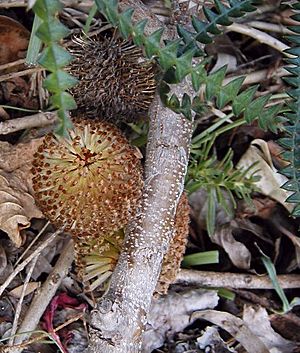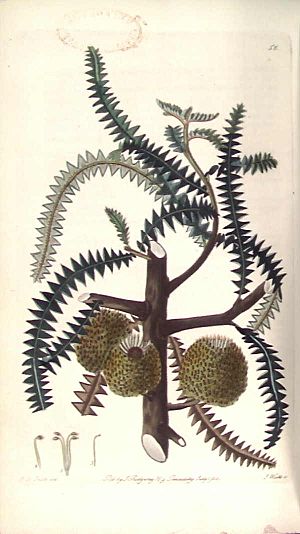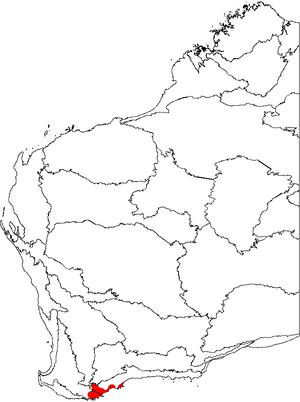Dryandra-leaved banksia facts for kids
Quick facts for kids Dryandra-leaved banksia |
|
|---|---|
 |
|
| Scientific classification | |
| Genus: |
Banksia
|
| Species: |
dryandroides
|
| Synonyms | |
|
|
The Banksia dryandroides, also known as the dryandra-leaved banksia, is a type of small shrub. It belongs to the plant group called Banksia. The Noongar people, who are Aboriginal Australians, call this plant manyat. You can find it growing in shrubland, woodland, and a special type of sandy land called kwongan. It grows along the south coast of Western Australia, between Narrikup and Beaufort Inlet. This species is so unique that it is placed alone in its own group, called series B. ser. Dryandroideae.
Contents
What it Looks Like
The Banksia dryandroides is a bushy shrub that spreads out and can grow up to 1 meter (about 3 feet) tall. It does not have a lignotuber, which is a woody base that helps some plants regrow after a fire. Its stems are covered with fine reddish hairs. The leaves look a bit like ferns. They are about 50-170 mm (2-6.7 inches) long and 7-15 mm (0.3-0.6 inches) wide.
Its flowers grow in squat, cylinder-shaped groups called inflorescences. These appear from October to January. They are 20-30 mm (0.8-1.2 inches) tall and are pale brownish in color. The flowers have hooked parts called pistils. After flowering, up to 25 seed pods, called follicles, grow on the old flower spikes. These pods are 15-30 mm (0.6-1.2 inches) long, 5-12 mm (0.2-0.5 inches) high, and 3-9 mm (0.1-0.4 inches) wide. They are covered in fine hairs on the bottom and are smooth on top.
How it was Discovered and Named
The first samples of B. dryandroides were collected in 1823. This happened near King George Sound by William Baxter, who was a plant collector. Baxter sent seeds to a nursery in Britain. These seeds grew successfully.
Later, a botanist named Robert Sweet saw the plant. In 1828, Sweet officially described the species in his book, Flora Australasica. He included a hand-colored drawing by Edwin Dalton Smith. This made B. dryandroides the first of 18 Banksia species found by Baxter to be officially named.
Sweet gave the plant the name dryandroides. This name means "Dryandra-like." It refers to how the leaves look similar to some plants in the Dryandra group.
Where it Grows
Banksia dryandroides grows near the south coast of Western Australia. You can find it from Narrikup to Beaufort Inlet. It prefers to grow in soils that are clay-loam, sandy loam, or gravel-based. These areas are usually low-lying. It grows in shrubland (areas with many shrubs) and low woodland (areas with small trees). It can also be found on higher areas with sandstone, in a type of habitat called kwongan.
How it Lives
When there is a fire, Banksia dryandroides plants are killed. However, new plants can grow from their seeds. These new plants need at least four years without fire to grow, flower, and produce new seeds.
This plant is somewhat sensitive to a plant disease called Phytophthora cinnamomi dieback. This disease can cause plants to die.
Scientists have studied how climate change might affect this species. They found that the area where it grows could shrink by 30% to 80% by the year 2080. This depends on how severe climate change becomes.
Growing it at Home
If you want to grow Banksia dryandroides from seeds, you don't need to do anything special to the seeds. They usually take between 30 to 80 days to sprout.



